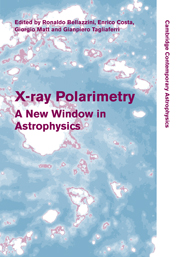Book contents
- Frontmatter
- Contents
- List of contributors
- Preface
- 1 X-ray polarimetry: historical remarks and other considerations
- Part I Polarimetry techniques
- 2 Scattering polarimetry in high-energy astronomy
- 3 Photoelectric polarimeters
- 4 Bragg crystal polarimeters
- 5 X-ray polarimetry with the photon-counting pixel detector Timepix
- 6 High-energy polarized photon interactions with matter: simulations with Geant4
- 7 The GPD as a polarimeter: theory and facts
- 8 Ideal gas electron multipliers (GEMs) for X-ray polarimeters
- 9 Broad-band soft X-ray polarimetry
- 10 Feasibility of X-ray photoelectric polarimeters with large field of view
- 11 Angular resolution of a photoelectric polarimeter
- 12 Development of a Thomson X-ray polarimeter
- 13 Hard X-ray / soft gamma-ray polarimetry using a Laue lens
- Part II Polarized emission in X-ray sources
- Part III Future missions
- Author index
- Subject index
12 - Development of a Thomson X-ray polarimeter
from Part I - Polarimetry techniques
Published online by Cambridge University Press: 06 July 2010
- Frontmatter
- Contents
- List of contributors
- Preface
- 1 X-ray polarimetry: historical remarks and other considerations
- Part I Polarimetry techniques
- 2 Scattering polarimetry in high-energy astronomy
- 3 Photoelectric polarimeters
- 4 Bragg crystal polarimeters
- 5 X-ray polarimetry with the photon-counting pixel detector Timepix
- 6 High-energy polarized photon interactions with matter: simulations with Geant4
- 7 The GPD as a polarimeter: theory and facts
- 8 Ideal gas electron multipliers (GEMs) for X-ray polarimeters
- 9 Broad-band soft X-ray polarimetry
- 10 Feasibility of X-ray photoelectric polarimeters with large field of view
- 11 Angular resolution of a photoelectric polarimeter
- 12 Development of a Thomson X-ray polarimeter
- 13 Hard X-ray / soft gamma-ray polarimetry using a Laue lens
- Part II Polarized emission in X-ray sources
- Part III Future missions
- Author index
- Subject index
Summary
We describe the current status of the design and development of a Thomson X-ray polarimeter suitable for a small satellite mission. Currently we are considering two detector geometries, one using rectangular detectors placed on four sides of a scattering element and the other using a single cylindrical detector with the scattering element at the center. The rectangular detector configuration has been fabricated and tested. The cylindrical detector is currently under fabrication. In order to compensate any pointing offset of the satellite, a collimator with a flat-topped response has been developed that provides a constant effective area over an angular range. We have also developed a double crystal monochromator/polarizer for the purpose of test and calibration of the polarimeter. Preliminary test results from the developmental activities are presented here.
Introduction
A Thomsom X-ray polarimeter experiment has been proposed for a small satellite mission of the Indian Space Research Organization (ISRO). Currently, a laboratory model has been developed. This experiment will be suitable for X-ray polarization measurement of hard X-ray sources like accretion powered pulsars, black hole candidates in low-hard states etc. For about 50 brightest X-ray sources a minimum detectable polarization of 2–3% will be achieved with the final configuration.
Two configurations are considered based on the geometry of the detector element: (1) rectangular detectors and (2) cylindrical detectors. The X-ray polarization will be measured by spinning the platform around the viewing axis. In both the cases, energy range covered will be 5–30 keV.
- Type
- Chapter
- Information
- X-ray PolarimetryA New Window in Astrophysics, pp. 83 - 87Publisher: Cambridge University PressPrint publication year: 2010
- 4
- Cited by



